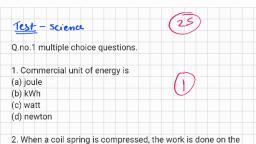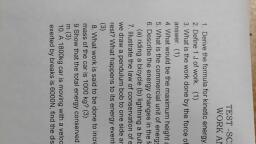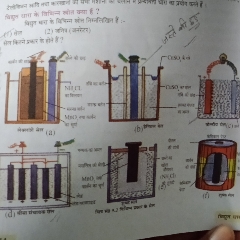Question 1 :
What is the equation of motion for the rocket, if $m$ is the mass of the rocket at a givenmoment, $\vec{w}$ is its acceleration, and $\vec{F}$ is the external force.
Question 2 :
The percentage change in the acceleration of the earth towards the Sun from a total eclipse of the Sun to the point where the Moon is on a side of earth directly opposite to the Sun is<br>
Question 3 :
A system of binary stars of masses ${m}_{A}$ and ${m}_{B}$ are moving in circular orbits of radii ${r}_{A}$ and ${r}_{B}$ respectively. If ${T}_{A}$ and ${T}_{B}$ are the time periods of masses ${m}_{A}$ and ${m}_{B}$ respectively then<br>
Question 4 :
$\text{A diametrical tunnel is dug across the earth. A ball is dropped into the tunnel from one side.}$<br>$\text{ The velocity of the ball when it reaches the centre of the earth is}$<br>$[\text{Given: gravitational potential at the centre of earth} = -\dfrac{ 3 }{2} \left( \dfrac{ GM }{ R } \right)$
Question 5 :
A moving body with a mass $m_1$ and velocity u strikes a stationary body of mass $m_2$. The masses $m_1$ and $m_2$ should be in the ratio $m_1/m_2$ so as to decrease the velocity of the first body to 2u/3 and giving a velocity of v to $m_2$ assuming a perfectly elastic impact. Then the ratio $m_1/m_2$ is :<br/>
Question 6 :
Four particles of masses $m, 2\ m, 3\ m$ and $4\ m$ are kept in sequence at the corners of a square of side $a.$ The magnitude of gravitational force acting on aparticle of mass $m$ placed at the center of the squarewill be.
Question 7 :
Two uniform solid spheres of equal radii R, but mass M and 4M have a centre to centre separation 6 R, the two spheres are held fixed on a horizontal floor. A projectile of mass m is projected from the surface of the sphere of mass M directly towards the centre of the second sphere. Obtain an expression for the minimum speed v of the projectile so that it reaches the surface of the second sphere<br/>
Question 9 :
Two spherical bodies of masses $m$ and $5\ M$ and radii $R$ and $2R$, respectively, are released in free space with initial separation between their centres equal to $12\ R$. If they attract each other due to gravitational force only, then the distance covered by the smaller body just before collision is<br>
Question 10 :
Read the assertion and reason carefully to mark the correct option out of the options given below :<br/>Assertion : At height $h$ from ground and at depth $h$ below ground, where h is approximately equal to $0.62 R$, the value of $g$ acceleration due to gravity is same.<br/><br/>Reason : Value of $g$ decreases both sides, in going up and down.
Question 11 :
A body starts from rest from a point distant ${r}_{0}$ from the centre of the earth. It reaches the surface of the earth whose radius is $R$. the velocity acquired by the body is<br>
Question 12 :
If the values of force and length are increased four times then the unit of energy will increases by?
Question 13 :
The gravitational field in a region is given by $\vec { E } =(5N{ kg }^{ -1 })\vec { i } +(12N{ kg }^{ -1 })\vec { j } $. Find the potential at the points $(12m,0)$ and $(0,5m)$ if the potential at the origin is taken to be zero.<br/>
Question 14 :
In a certain region of space, the gravitational field is given by $-\dfrac {k} {r}$, where r is the distance and k is a constant. If the gravitational potential at$ r = r_0$ be $V_0$, then what is the expression for the gravitational potential (V).
Question 15 :
A mass is suspended from the end of a spring. When the system is oscillating the amplitude of oscillation is $4 \ cm$ and the maximum kinetic energy of oscillation of the system is $1\  joule$. Then the force constant of the spring is:
Question 16 :
A particle of mass 'm'describe circular path of radius 'r ' such that its kinetic energy is given by $ K = as^2 $ 's ' is the distance travelled 'a'is constant :
Question 17 :
Two bodies with masses $M_1$ and $M_2$ are initially at the rest and a distance $R$ apart. Then they move directly towards one another under the influence of their mutual gravitational attraction. What is the ratio of the distances traveled by $M_1$ to the distance traveled by $M_2$?
Question 18 :
A body is projected at an angle of $60 ^{0}$ with the horizontal. If its kinetic energy at maximum height is 10 J, then the height at which potential energy and kinetic energy have equal values (consider P.E. at the point of projection to be zero) is :
Question 19 :
A body starts from rest from a point distance $R_0$ from the centre of the earth of mass M, radius R.. The velocity acquired by the body when it reaches the surface of the earth will be
Question 20 :
A projectile is fired vertically upwards from the surface of the earth with a velocity $k{v}_{e}$ where ${v}_{e}$ is the escape velocity and $k<1$. If $R$ is the radius of the earth, the maximum height to which it will rise measured from the centre of earth will be (neglect air resistance)<br>
Question 21 :
A person brings amass of $1kg$ from infinity to a pointA lnitially, the mass was at rest but it moves at aspeed of $3 m/s$ as it reaches A. The work done by the person on the mass is $- 5.5 J$The gravitationalpotential at $A$ is
Question 22 :
The height from the surface of earth at which the gravitational potential energy of a ball of mass $m$ is half of that at the centre of earth is (where $R$ is the radius of earth)<br>
Question 23 :
A tunnel is dug along the diameter ofthe earth. There is a particle of mass $m$ at the centre of the tunnel. Find the minimum velocity given to the particle so that is just reaches to the surface of the earth. $(R =$ radius of earth)
Question 24 :
A tunnel is dug along the diameter of the earth (radius $R$ and mass $M$). There is a particle of mass $'m'$ at the centre of the tunnel. Find the minimum velocity given to the particle so that it just reaches to the surface of the earth is<br>
Question 25 :
Displacement of a body is $\displaystyle \left( 5\overline { i } +3\overline { j } -4\overline { k }  \right) m$ when a force $\displaystyle \left( 6\overline { i } +6\overline { j } +4\overline { k }  \right) N$ acts for $5 \ s$. The power in watt is:
Question 26 :
If the gravitational acceleration at surface of earth is $ g$, then increase in potential energy in lifting an object of mass $m$ to a height equal to the radius $R$ of earth will be.
Question 27 :
A bullet of mass $5g$ travels with a speed of $500ms^{-1}.$ if it penetrates a fixed target which offers a constant resistive force of 1000 N to the motion of the bullet, find :<br><br>(a) the initial kinetic energy of the bullet,<br><br>(b) the distance through which the bullet has penetrated.
Question 28 :
A particle of mass $4m$ which is at rest explodes into three fragments. Two of the fragments each of mass $m$ are found to move with a speed $v$ each in mutually perpendicular directions. The energy released in the process of explosion is:
Question 29 :
The gravitational field due to a mass distribution is E=$\dfrac {K} {x^3}$ the x-direction. (K is a constant). Taking the gravitational potential to be zero at infinity, its value at the a distance x is:
Question 30 :
A particle of mass $m$ is projected from the surface of earth with a speed $V_{0}$ ($V_{0}$ < escape velocity). The speed of the particle at a height h$=$R (radius of the earth) is<br/>




























